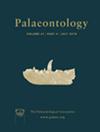华北川岭沟地层的大型化石:晚古生代多细胞藻类起源较早的证据
IF 2.3
2区 地球科学
Q1 PALEONTOLOGY
引用次数: 0
摘要
多细胞藻类是了解地球早期生命进化的核心课题。然而,多细胞藻类的起源和细胞分化的时间仍然很不明确。古近纪到中新生代早期是多细胞藻类开始在海洋环境中出现和演化的关键时期。本文报告了华北川岭沟地层(约 1.64 Ga)页岩中保存完好的多细胞化石,重点介绍了它们的固着器和推测的细胞结构。这些大型藻类化石具有合理的多样性,包括圆环藻、中华褐藻、罗布麻褐藻、椭圆藻、藻类、团山藻和长城藻;主要以碳质压积物形式保存,也有少量蛛网膜化形式。场发射扫描电子显微镜(FESEM)观察发现了Chuaria的多细胞结构,证实了其多细胞真核生物的生物属性,为多细胞藻类起源于古近纪末期提供了直接证据,早于之前的推测。Tuanshanzia sp.和 Changchengia sp.以裸露的根茎固着方式发育,表明它们在古近代晚期的海洋栖息地过着底栖无梗的生活方式。本文章由计算机程序翻译,如有差异,请以英文原文为准。
Macroscopic fossils from the Chuanlinggou Formation of North China: evidence for an earlier origin of multicellular algae in the late Palaeoproterozoic
Multicellular algae are the core topic for understanding the early life evolution on Earth. The timing of origin and cellular differentiation of multicellular algae, however, remains poorly constrained. The Palaeoproterozoic to early Mesoproterozoic is a critical period during which multicellular algae began to occur and evolve in marine environments. This paper reports well-preserved multicellular fossils from shales of the Chuanlinggou Formation (c. 1.64 Ga) in North China, with emphasis on their holdfast and putative cellular structures. These macroalgal fossils are reasonably diversified and include Chuaria circularis, Tawuia sinensis, Tawuia robusta, Glossophyton ovalis, Glossophyton sp., Tuanshanzia sp. and Changchengia sp.; mainly preserved as carbonaceous compressions, with a few sideritized forms. Field emission scanning electron microscope (FESEM) observation revealed multicellular structures in Chuaria, confirming its biological attributes of a multicellular eukaryote and providing direct evidence that multicellular algae had already originated by the terminal Palaeoproterozoic, earlier than previously speculated. Tuanshanzia sp. and Changchengia sp. developed with a bare rhizome holdfast, suggesting that they had a benthic sessile lifestyle in their late Palaeoproterozoic oceanic habitat.
求助全文
通过发布文献求助,成功后即可免费获取论文全文。
去求助
来源期刊

Palaeontology
地学-古生物学
CiteScore
5.60
自引率
3.80%
发文量
43
审稿时长
6 months
期刊介绍:
Palaeontology publishes a wide variety of papers on palaeontological topics covering:
palaeozoology
palaeobotany
systematic studies
palaeoecology
micropalaeontology
palaeobiogeography
functional morphology
stratigraphy
taxonomy
taphonomy
palaeoenvironmental reconstruction
palaeoclimate analysis and biomineralization studies.
 求助内容:
求助内容: 应助结果提醒方式:
应助结果提醒方式:


